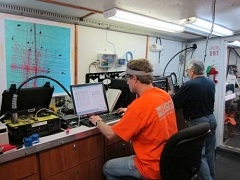- Home page /
- News /
- Company news /
- New insight on gas hydrates in Gulf of Mexico
New insight on gas hydrates in Gulf of Mexico

The expedition and the data and imagery collected resulted from long-standing cooperation between the U.S. Department of the Interior’s U.S. Geological Survey (USGS) and Bureau of Ocean Energy Management (BOEM) and the U.S. Department of Energy (DOE). This collaboration aims to advance scientific understanding of gas hydrates, an important potential future energy resource.
Gas hydrates are ice-like substances formed when certain gases combine with water at specific pressures and temperatures. Deposits of gas hydrates are widespread in marine sediments beneath the ocean floor and in sediments within and beneath permafrost areas, where pressure-temperature conditions keep the gas trapped in the hydrate structure. Methane is the gas most often trapped in these deposits, making gas hydrates a potentially significant source for natural gas around the world.
The recently completed expedition was planned jointly by USGS, DOE, and BOEM, and was executed by USGS. Using low-energy seismic sources, USGS scientists collected details about the nature of the gas hydrate reservoirs and about geologic features of the sediment between the reservoirs and the seafloor.
The data were collected at two locations in the Gulf of Mexico where the three federal agencies partnered with an industry consortium to conduct a drilling expedition in 2009. That expedition discovered gas hydrate filling between 50 and 90 percent of the available pore space between sediment grains in sandy layers in the subsurface. These reservoirs are expected to be representative of the 6,700 trillion cubic feet of gas that BOEM estimates is housed in gas hydrates in sand-rich reservoirs in the northern Gulf of Mexico.
The new data are being used to refine estimates of the nature, distribution, and concentration of gas hydrate in the vicinity of the 2009 drill sites. This will help assess how useful specialized seismic data may be to estimating hydrate saturations in deepwater sediments.

